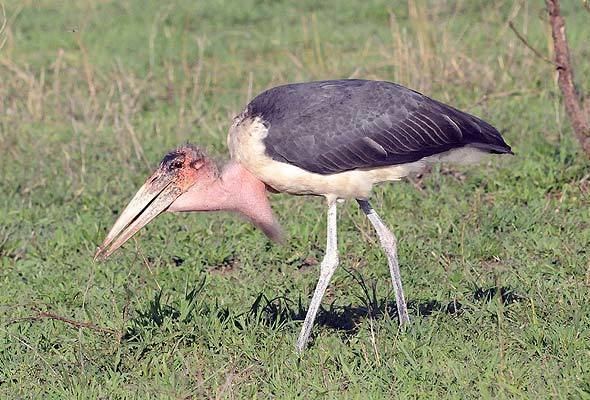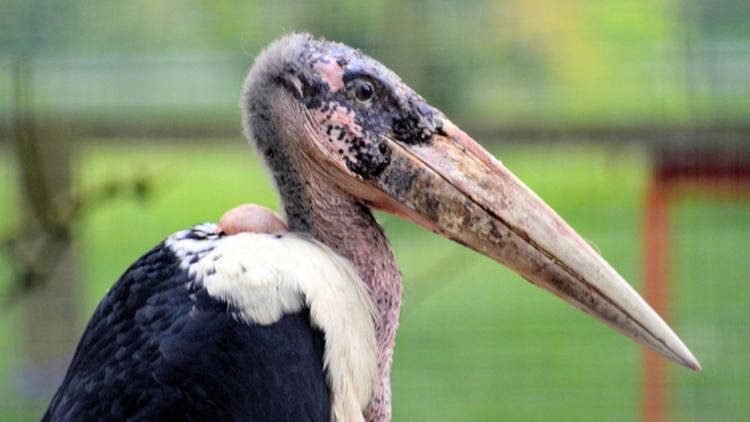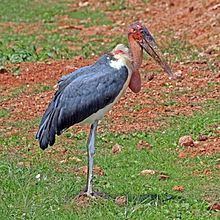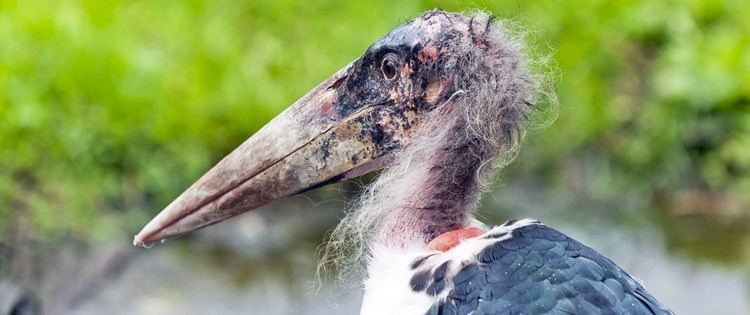Mass 4.5 – 8 kg (Adult) Clutch size 2 – 3 | Family Ciconiidae Species L. crumenifer Wingspan 2.2 – 2.9 m (Adult) Higher classification Leptoptilos | |
 | ||
Length 1.2 – 1.3 m (Adult, From bill to tail) Similar Leptoptilos, Stork, Greater adjutant | ||
Marabou stork the undertaker bird is showing of in the heat
The marabou stork (Leptoptilos crumenifer, sometimes leptoptilos crumeniferus) is a large wading bird in the stork family Ciconiidae. It breeds in Africa south of the Sahara, in both wet and arid habitats, often near human habitation, especially landfill sites. It is sometimes called the "undertaker bird" due to its shape from behind: cloak-like wings and back, skinny white legs, and sometimes a large white mass of "hair".
Contents
- Marabou stork the undertaker bird is showing of in the heat
- Birds of uganda the marabou stork
- Etymology
- Description
- Behavior
- Feeding behavior
- Human uses
- References

Birds of uganda the marabou stork
Etymology

The name marabou is thought to be derived from the Arabic word murābit meaning quiet or hermit-like. The species was originally described in the stork genus Ciconia as Ciconia crumenifera by Lesson. The species was moved into the genus Leptoptilos and the ending was modified to crumeniferus and used by many authors until it was noted that the correct masculine ending to match the genus is crumenifer.
Description

The marabou stork is a massive bird: large specimens are thought to reach a height of 152 cm (60 in) and a weight of 9 kg (20 lb). A wingspan of 3.7 m (12 ft) was accepted by Fisher and Peterson, who ranked the species as having the largest wing-spread of any living bird. Even higher measurements of up to 4.06 m (13.3 ft) have been reported, although no measurement over 3.20 m (10.5 ft) has been verified. It is often credited with the largest spread of any landbird, to rival the Andean condor; more typically, however, these storks measure 225–287 cm (7–9 ft) across the wings, which is about a foot less than the average Andean condor wingspan and nearly two feet less than the average of the largest albatrosses and pelicans. Typical weight is 4.5–8 kg (9.9–17.6 lb), unusually as low as 4 kg (8.8 lb), and length (from bill to tail) is 120 to 130 cm (47 to 51 in). Females are smaller than males. Bill length can range from 26.4 to 35 cm (10.4 to 13.8 in). Unlike most storks, the three Leptoptilos species fly with the neck retracted like a heron.

The marabou is unmistakable due to its size, bare head and neck, black back, and white underparts. It has a huge bill, a pink gular sac at its throat (crumenifer(us) means "carrier of a pouch for money at the neck"), a neck ruff, and black legs and wings. The sexes are alike, but the young bird is browner and has a smaller bill. Full maturity is not reached for up to four years.
Behavior
Like most storks, the marabou is gregarious and a colonial breeder. In the African dry season (when food is more readily available as the pools shrink) it builds a tree nest in which two or three eggs are laid. It is known to be quite ill-tempered.
It also resembles other storks in that it is not very vocal, but indulges in bill-rattling courtship displays. The throat sac is also used to make various noises at that time.
A number of endoparasites have been identified in wild marabous including Cheilospirura, Echinura and Acuaria nematodes, Amoebotaenia sphenoides (Cestoda) and Dicrocoelium hospes (Trematoda).
Feeding behavior
The marabou stork is a frequent scavenger, and the naked head and neck are adaptations to this livelihood, as it is with the vultures with which the stork often feeds. In both cases, a feathered head would become rapidly clotted with blood and other substances when the bird's head was inside a large corpse, and the bare head is easier to keep clean.
This large and powerful bird eats mainly carrion, scraps and faeces but will opportunistically eat almost any animal matter it can swallow. It occasionally eats other birds including Quelea nestlings, pigeons, doves, pelican and cormorant chicks, and even flamingos. During the breeding season, adults scale back on carrion and take mostly small, live prey since nestlings need this kind of food to survive. Common prey at this time may consist of fish, frogs, insects, eggs, small mammals and reptiles such as crocodile hatchlings and eggs. Though known to eat putrid and seemingly inedible foods, these storks may sometimes wash food in water to remove soil. When feeding on carrion, marabou frequently follow vultures, which are better equipped with hooked bills for tearing through carrion meat and may wait for the vultures to cast aside a piece, steal a piece of meat directly from the vulture or wait until the vultures are done. As with vultures, marabou storks perform an important natural function by cleaning areas via their ingestion of carrion and waste. Increasingly, marabous have become dependent on human garbage and hundreds of the huge birds can be found around African dumps or waiting for a hand out in urban areas. Marabous eating human garbage have been seen to devour virtually anything that they can swallow, including shoes and pieces of metal. Marabous conditioned to eating from human sources have been known to lash out when refused food.
Human uses
Marabou down is frequently used in the trimming of various items of clothing and hats, as well as fishing lures. Turkey down and similar feathers have been used as a substitute for making 'marabou' trimming.
